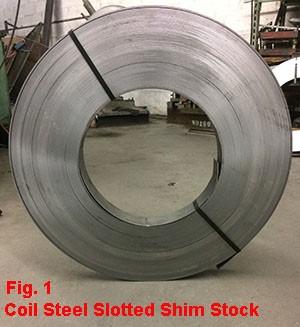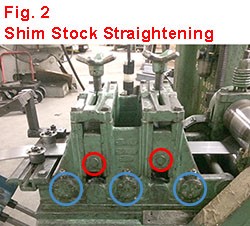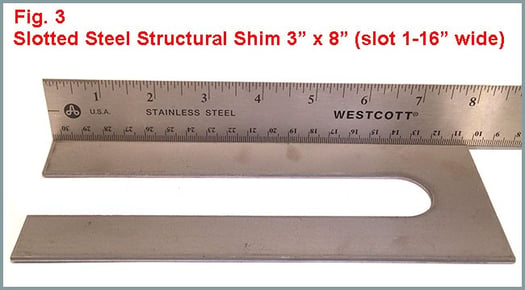The Steel Supply Company uses a variety of processes when manufacturing Slotted Steel Shims. For stock sizes Punch and Die Stamping is the most effective. For made to order sizes or multiple slot shims laser cutting produces very accurate results. Heavier material like 1/2” thick or thicker tends to be more economical using a High Definition Plasma table. Regardless of the process our customer, the steel fabricator and erector, requires the same thing, i.e. accurate, flat shims that can be installed with no hesitation or interruption and that provide 100% surface contact.
One not so obvious thing that has to be considered when manufacturing steel shims is the shape of the material in raw form. For efficiency of transportation and storage raw steel is often rolled into coils.  This introduces stress into the steel that will remain after the steel is re-straightened. Note: the process of straightening coil steel can also be referred to as Leveling or Flattening.
This introduces stress into the steel that will remain after the steel is re-straightened. Note: the process of straightening coil steel can also be referred to as Leveling or Flattening.
While steel up to 1” thick can be purchased in coils, to assure flatness in the finished Slotted Steel Shim any raw material we use from 1/4” thick and above is always hot rolled flat bar. This eliminates the cost of the straightening rollers and reduces the possibility of deflection from stress relief in the finished shim.
With thicker material, this is very important for shims being used in any structural or load bearing application. In these cases any warping, twisting or deflection in the shim can create enough resistance to cause a TC Bolt tip to snap off even though positive contact between all surfaces has not been made.
For Slotted Steel Shims in thicknesses 1/32”, 1/16”, 1/8” and 3/16” coiled steel is used. Just as with the thicker material shims the quality of the finished stamped steel product is based on;
- Quality raw material from dependable steel mills
- Properly designed Punch and Die sets. Note: as far as we know there are no stock punches that will create a Slotted Steel Shim in a stamping press. Customized tools are made for these items.
- Proper maintenance of all aspects of the tooling.
- Punch and dies are kept sharp.
- Proper tonnage applied by the stamping machine. Note: These are flywheel driven stamping machines, not ironworkers.
- Properly down stroke cycle timing.
Understanding that deflection is a fact of steel stamping, these thinner sizes can be coiled, straightened and stamped. Any deflection that does occur will be well within tolerances and will easily flatten when the pressure of a TC Bolt is applied.
 Regardless of the thickness starting with coil stock presents stress in the steel that should be accounted for. The coiling process naturally stretches the outer surface. As it is un-coiled that expansion will result in a longitudinal curve known as the “Coil Set”. Removing this curve requires the inner radius to be expanded and to a lesser degree the outer radius to be compressed.
Regardless of the thickness starting with coil stock presents stress in the steel that should be accounted for. The coiling process naturally stretches the outer surface. As it is un-coiled that expansion will result in a longitudinal curve known as the “Coil Set”. Removing this curve requires the inner radius to be expanded and to a lesser degree the outer radius to be compressed.
Fig. 2 shows the straightening process. The stock coil is coming in from the right. The straighten steel feeds out the left side and into a 240-ton Punch and Die Stamping machine where it is making Structural Shims 3” wide, 8” long with a 1-1/16” wide slot.
The straightener shown is a 5 roller model. The 3 blue circles show the axle of each lower roller. These are all at the same level and remain fixed. The two red circles show the upper roller locations. The tension handles on top will adjust these upper rollers so they exert the right amount of pressure to counteract the coil set in the material. The upper right roller, on the infeed side will do almost all of the straightening. Any remaining minor deviation is corrected in the outfeed roller (red circle on left).
The finished product, shown in Figure 3, is a completely flat 3” x 8” x 1/8” thick Slotted Structural Steel Shim. If it is installed with the plain steel finish it will remain exactly as shown. What is important to understand is that while flat, there is still stress in the steel. One way to understand this is to look back at the coiled roll in Figure 1. The roll is approximately 4’ in outside diameter and 18” in inside diameter. This means the coil set, or curve of an 8” piece taken from the innermost coil is likely to have twice the arc of an 8” piece taken from the outside coil.
Both pieces went through the straightener at the same settings and under the same pressure. While both are perfectly flat the 8” piece from the inner loop of the coil will have more stress existing in the steel. This becomes important when the shim is Hot Dip Galvanized.
The molten zinc kettle tends to run between 840° and 850°F. Emersion will last between 5 and 10 minutes, so the steel will reach ambient temperature before it is removed. As its temperature increases the steel shim is expanding and the stress will relieve itself, causing bending or warping. Further, all small items such as shims are removed from the zinc kettle and spun in a centrifuge to allow any extra liquid zinc to evacuate. This high speed spinner will exert centrifugal force on the shims that coupled with the existing unrelieved stress can cause additional warping or deflection.





